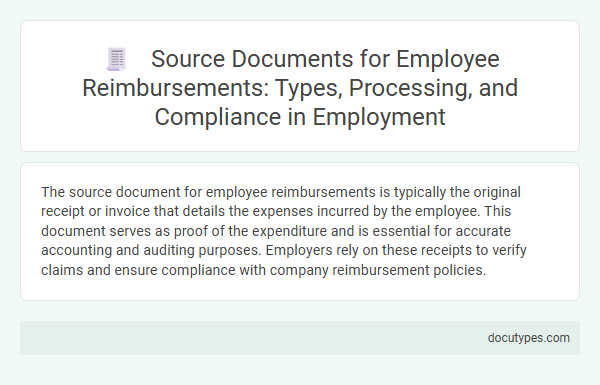The source document for employee reimbursements is typically the original receipt or invoice that details the expenses incurred by the employee. This document serves as proof of the expenditure and is essential for accurate accounting and auditing purposes. Employers rely on these receipts to verify claims and ensure compliance with company reimbursement policies.
Introduction to Employee Reimbursement Source Documents
Understanding the source document for employee reimbursements is essential for accurate financial reporting and compliance. These documents serve as critical evidence for expenses incurred during business activities.
- Definition of Source Document - It is the original record that verifies the details of employee expenses for reimbursement purposes.
- Common Examples - Receipts, invoices, and travel expense reports typically function as source documents in reimbursement processes.
- Importance for Your Records - Proper documentation ensures transparent tracking and validation of all reimbursed costs.
Key Types of Source Documents for Reimbursements
The source document for employee reimbursements is the original paperwork that validates the expense incurred by an employee. These documents ensure accurate accounting and proper approval for reimbursement claims.
Key types of source documents for reimbursements include receipts, invoices, and mileage logs. Receipts provide proof of purchase for items or services paid out-of-pocket. Invoices detail charges from vendors, while mileage logs track business travel distances to calculate compensation.
Importance of Accurate Documentation in Employment Reimbursements
| Topic | Description |
|---|---|
| Source Document for Employee Reimbursements | Source documents for employee reimbursements include receipts, invoices, payment vouchers, and travel expense reports. These documents serve as proof of expenses incurred by employees on behalf of the company. |
| Importance of Accurate Documentation | Accurate documentation ensures proper verification and transparency during the reimbursement process. It helps prevent errors, fraud, and disputes, maintaining financial integrity within the organization. |
| Role in Employment Reimbursements | Employers rely on precise source documents to comply with accounting standards and tax regulations. Proper documentation supports compliance audits and financial reporting requirements. |
| Impact on Employees | You must provide original and detailed receipts to facilitate timely and correct reimbursement. Clear records also simplify expense tracking and personal financial management. |
Receipts and Invoices: Essential Evidence for Claims
Receipts and invoices serve as the primary source documents for employee reimbursements, providing essential proof of expenses incurred. Accurate documentation supports your reimbursement claims and ensures compliance with company policies.
- Receipts - Detailed proof of payment showing the date, amount, and items purchased or services rendered.
- Invoices - Formal requests for payment issued by vendors, outlining the charges and terms related to goods or services.
- Compliance - Proper source documents help verify legitimate business expenses and maintain transparent financial records.
Travel and Expense Reports: Standard Source Documents
The source document for employee reimbursements primarily includes travel and expense reports. These reports serve as standard source documents, capturing essential details of incurred expenses.
Your travel and expense reports detail dates, amounts, and business purposes, ensuring accurate reimbursement processing. Proper documentation within these reports supports audit compliance and financial transparency.
Digital vs. Paper Source Documents: Trends and Best Practices
Source documents for employee reimbursements are crucial for verifying expenses and ensuring accurate financial records. The shift from paper to digital documentation is transforming how organizations manage these records efficiently and securely.
- Digital Receipts Are Increasingly Preferred - Employers and employees favor digital receipts for ease of submission and quicker processing times.
- Paper Documents Still Hold Legal Value - Physical receipts remain important for audits and compliance, especially in industries with strict regulatory requirements.
- Automated Expense Management Systems Enhance Accuracy - Integration of digital source documents with software reduces errors and streamlines reimbursement approvals.
Combining digital solutions with strategic retention of essential paper documents creates the best practices for modern employee reimbursement management.
Processing Employee Reimbursement Source Documents
The source document for employee reimbursements is typically the original receipt or invoice submitted by the employee as proof of expenses incurred. Processing employee reimbursement source documents involves verifying the authenticity, completeness, and compliance with company policies. Accurate documentation ensures proper accounting and timely reimbursement to employees.
Compliance Requirements for Reimbursement Documentation
The source document for employee reimbursements is typically the original receipt or invoice that validates the expense incurred. This documentation must clearly show the date, amount, and nature of the expense to meet compliance standards.
Maintaining accurate and detailed reimbursement records ensures adherence to company policies and tax regulations. Your ability to provide proper source documents helps prevent audit issues and supports transparent financial practices.
Common Errors and How to Avoid Them in Source Document Handling
The source document for employee reimbursements is typically the original receipt or invoice that verifies the purchase or expense incurred. Common errors include missing receipts, incorrect dates, or incomplete information, which can delay processing and lead to reimbursement disputes. To avoid these issues, ensure you collect and submit detailed, legible documents promptly and cross-verify all expense details before submission.
What Is the Source Document for Employee Reimbursements? Infographic

